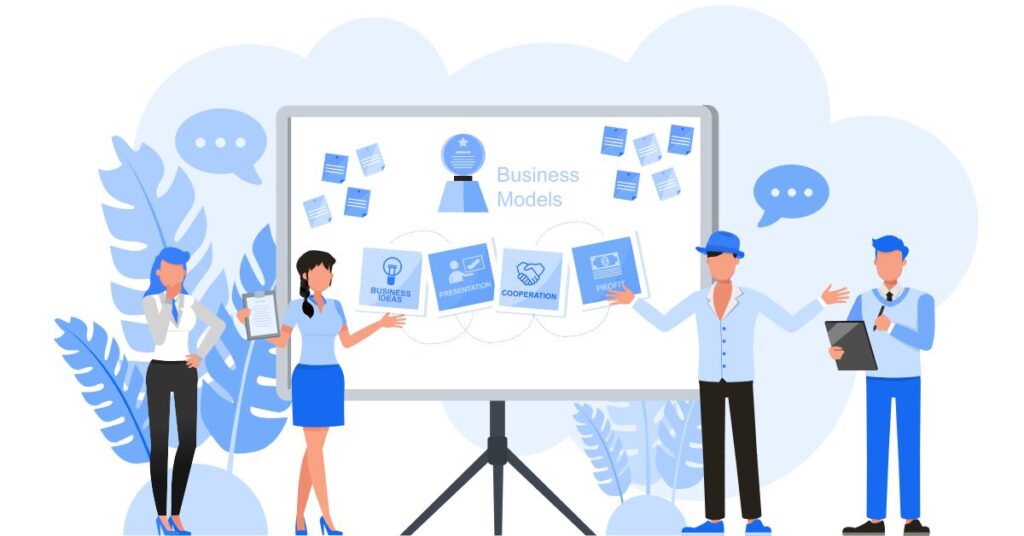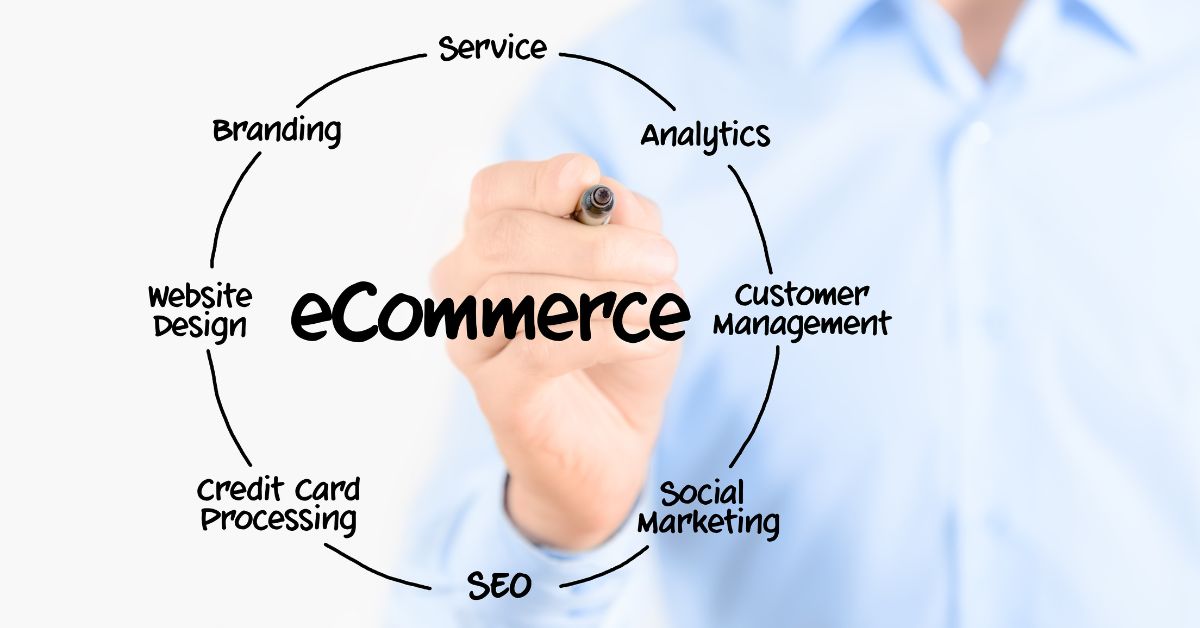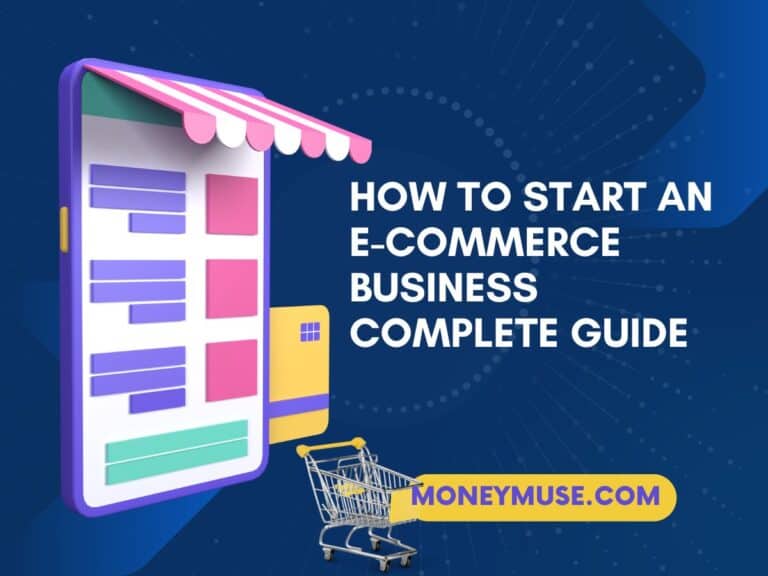What Is An eCommerce Business?
eCommerce Business
An eCommerce business model allows companies to sell products and/or services online. The term eCommerce is derived from “electronic commerce” and refers to buying and selling goods and services through electronic devices, such as computers and mobile devices. In an e-commerce business, transactions are conducted online through a website or a mobile application, and payments are made electronically through credit cards, PayPal, or other digital payment systems. E-commerce businesses can range from small, single-product shops to large, multi-national corporations, including B2C (business-to-consumer) and B2B (business-to-business) transactions.
One of the key advantages of e-commerce businesses is the ability to reach a global customer base with minimal physical overhead. This allows companies to expand their market reach and increase their customer base, leading to increased revenue and profitability. Additionally, e-commerce businesses can be operated 24/7, allowing customers to shop anytime and anywhere, making it a convenient option for busy consumers.

To be successful in e-commerce, businesses must have a robust online presence, including a well-designed website with a user-friendly interface, an efficient payment and shipping system, and effective marketing strategies to reach their target audience. It’s also vital for e-commerce businesses to maintain high customer satisfaction by providing timely and accurate information, quick delivery, and responsive customer service.
Overall, e-commerce has revolutionized how we do business, enabling entrepreneurs and established companies to reach a wider audience, increase their profits, and provide consumers with a convenient and efficient shopping experience.

E-commerce business models
E-commerce business models refer to how an e-commerce business can generate revenue and operate in the online marketplace. These models provide a framework for how a business can sell its products or services, reach its target customers, and create a sustainable revenue stream. Some standard e-commerce business models include:
- B2C (Business-to-Consumer) Model: This model involves selling products or services directly to end consumers without intermediaries. This is the most common e-commerce business model and includes online retail stores, marketplaces, and direct-to-consumer (D2C) brands.
- B2B (Business-to-Business) Model: This model involves selling products or services to other businesses, rather than directly to consumers. This can include wholesalers, suppliers, and manufacturers who sell their products to retailers, distributors, and other businesses.
- Marketplace Model: This model involves creating a platform where multiple sellers can list and sell their products to consumers. The marketplace owner earns a commission on each sale or charges a fee for listing products on the platform. Examples of marketplace models include Amazon, Etsy, and eBay.
- Subscription Model: This model involves offering a service or a product on a recurring subscription basis, typically monthly or annually. This can include software as a service (SaaS) platforms, content providers, and product delivery services.
- Dropshipping Model: This model involves selling products without holding any inventory. The business partners with a supplier who handles the storage and shipping of the products directly to the customer. The business earns a profit by marking up the price of the products.
- Freemium Model: This model offers a basic version of a product or service for free, with premium features available for a fee. This can include software and app developers, online games, and content providers.
- Hybrid Model: This model combines elements of multiple e-commerce business models to create a unique and customized approach. For example, a B2C retailer may also offer a subscription service for repeat customers.
Each eCommerce business model has its own strengths and weaknesses, and the best model for a particular business will depend on its specific goals, target customers, and competitive environment. Companies must clearly understand their target audience, competitive landscape, and the resources and capabilities required to implement and execute their chosen business model to succeed.

Importance of Starting an eCommerce Business
Growing Online Market: With the increasing use of the internet and mobile devices, e-commerce is growing rapidly, providing businesses with a large customer base.
Increased Reach: An e-commerce business can reach customers worldwide, making it possible to tap into new markets and customer segments.
Lower Costs: Starting an e-commerce business can often be done with lower costs than traditional brick-and-mortar businesses. This eliminates the need for physical storefronts, inventory, and other traditional business expenses.
Increased Flexibility: An e-commerce business allows for greater flexibility regarding working hours and location, making it possible to work from anywhere with an internet connection.
Purpose of the Guide to Provide a Comprehensive Overview:
The guide provides a comprehensive overview of all the essential aspects of starting an e-commerce business, from defining your niche to managing your business. The guide offers practical tips and strategies to help you build a successful e-commerce business. This guide aims to empower individuals to take the first step toward starting their own e-commerce business.
Whether you are a seasoned entrepreneur or just starting out, the guide provides valuable information and insights to help you succeed. The guide encourages innovation and creativity in e-commerce by providing practical advice and strategies for building a unique and successful business. In this guide, you will learn the importance of starting an e-commerce business and the purpose of the guide.
The e-commerce market is growing rapidly and offers businesses a large and growing customer base, increased reach, lower costs, and increased flexibility. The guide provides a comprehensive overview of all the essential aspects of starting an e-commerce business and offers practical tips and strategies to help you build a successful business. The blog aims to empower individuals to start their own e-commerce businesses, encourage innovation, and provide valuable information and insights to help them succeed.

Finding your e-commerce niche
Finding your e-commerce niche is crucial in starting a successful online business. A niche refers to a specific market segment that you cater to, providing detailed products or services that meet the needs of your target customers. A well-defined niche will help you stand out from the competition and attract customers actively searching for your products or services.
There are several steps involved in finding your e-commerce niche:
- Identify Your Passion: The first step to finding your niche is to identify what you are passionate about. Choose a niche that aligns with your interests, hobbies, and expertise. This will help you stay motivated and engaged in your business, even during challenging times.
- Research Your Market: Conduct market research to determine the potential demand for your niche. Analyze data such as market size, competition, customer demographics, and buying habits. This will help you choose the viability of your niche and identify potential growth opportunities.
- Identify Your Unique Value Proposition: Determine what makes your business unique and what differentiates you from your competition. This is known as your unique value proposition, which will attract customers to your business.
- Test Your Niche: Testing your niche before launching your e-commerce business is a good idea. This can be done through surveys, focus groups, or beta testing with a small group of customers. This will help you validate your niche and make necessary adjustments before launching your business.
- Specialize in a Sub-niche: Consider specializing in a sub-niche within your market. For example, consider specializing in pet grooming products if your market is pet products. This will help you differentiate yourself from your competition and cater to a more specific group of customers.
Finding your e-commerce niche is important in starting a successful online business. By identifying your passion, researching your market, and your unique value proposition, you will build a business that stands out from the competition and attracts customers actively searching for your products or services.

e-commerce business plan
Creating a comprehensive e-commerce business plan is essential in starting and growing a successful online business. A business plan serves as a roadmap for your business, outlining your goals, strategies, and financial projections. A well-developed business plan will help you secure funding, attract investors, and ensure your business is on track to achieve its goals.
The following are the critical components of an effective e-commerce business plan:
- Executive Summary: This section provides a high-level business overview, including your mission, products or services, target market, and financial projections.
- Company Description: In this section, you will describe your company’s history, ownership structure, and management team. You will also outline your company’s mission statement and values.
- Market Analysis: This section provides an in-depth analysis of your target market, including demographic information, buying habits, and market trends. You will also analyze your competition and its strengths and weaknesses.
- Product/Service Line: In this section, you will describe your products or services in detail, including how they meet the needs of your target market and how they are differentiated from your competition.
- Marketing and Sales Strategy: This section outlines your strategies, including your target market, marketing channels, and sales tactics. You will also describe your pricing strategy and how to build brand awareness.
- Operations Plan: In this section, you will describe how your business will operate, including your production process, supply chain, and fulfillment process. You will also outline your technology and infrastructure needs.
- Financial Projections: This section provides financial projections for your business, including revenue and expense projections, cash flow projections, and break-even analysis.
Creating a comprehensive e-commerce business plan is vital in starting and growing a successful online business. By outlining your goals, strategies, and financial projections, you can secure funding, attract investors, and ensure your business is on track to achieve its goals.

How much does it cost to start an e-commerce business?
Starting an e-commerce business can be a cost-effective way to enter the world of entrepreneurship, but it still requires significant financial investment. The cost of creating an e-commerce business will vary depending on several factors, including the size and scale of the company, the products and services offered, and the marketing and technology investments required. In this guide, we’ll cover the key costs you should consider when starting an e-commerce business.
- Product costs: The cost of the products you want to sell will be a significant factor in your overall budget. This includes the cost of goods, shipping, and handling. Consider bulk purchasing to reduce product costs.
- Website development: Building a professional e-commerce website will require a significant investment. Hiring a web designer and developer can cost several thousand dollars, while using an e-commerce platform can cost a few hundred dollars annually.
- Marketing and advertising: Marketing and advertising are critical components of any e-commerce business and require significant investment. This includes costs for paid advertising, email marketing, and influencer marketing.
- Payment processing: Accepting payments through your e-commerce website will require a payment gateway and merchant account. Fees for payment processing can range from a few cents to several percent per transaction, depending on the provider.
- Logistics and fulfillment: Shipping and handling costs will be a significant factor in your budget, especially if you offer free shipping. Consider using a fulfillment center or third-party logistics provider to reduce costs.
- Business licenses and permits: Depending on your location and the products and services offered, you may need to obtain business licenses and permits. These fees can range from a few hundred to several thousand dollars.
- Technology and software: Running an e-commerce business will require various software and technology solutions, including an e-commerce platform, email marketing software, and customer relationship management (CRM) software. These costs can range from a few dollars per month to several thousand dollars per year.
Starting an e-commerce business will vary depending on several factors, including product costs, website development, marketing and advertising, payment processing, logistics and fulfillment, business licenses and permits, and technology and software. Plan your budget carefully, and consider the key costs of starting an e-commerce business to ensure your business is financially viable.
Rough Estimates
- Website development: $500 – $10,000+
- Marketing and advertising: $500 – $10,000+
- Payment processing: 2% – 3% per transaction
- Logistics and fulfillment: $500 – $5,000+
- Business licenses and permits: $50 – $1,000+
- Technology and software: $50 – $500+ per month
Note: These are rough estimates only, and actual costs can vary widely depending on factors such as the size and scale of your business, the products and services offered, and the marketing and technology investments required. It’s always best to carefully research and plan your budget based on your needs and goals.

Is e-commerce a profitable business?
E-commerce can be a profitable business, but it is not a guarantee. Like any other business model, the profitability of an e-commerce business depends on various factors such as the niche, target market, marketing strategy, operating costs, and competition.
Here are some key considerations to help determine if an e-commerce business is likely to be profitable:
- Market demand: Is a large enough market for your products or services? Are people actively searching for and willing to pay for what you offer?
- Competition: How much competition is there in your niche, and how well-established are the existing players? Are there any barriers to entry, and how can you differentiate your offering?
- Operating costs: What are the costs of producing, storing, and shipping your products? What are the marketing, technology, and support costs associated with running your business?
- Margins: What is your profit margin, and how does it compare to the industry average? Can you generate enough revenue to cover your costs and make a profit?
Ultimately, the profitability of an e-commerce business will depend on many variables and is not something that can be guaranteed. However, with proper planning, research, and execution, e-commerce businesses have the potential to be highly profitable.

Making Your eCommerce Website
An e-commerce website is critical in starting an online business and reaching customers. A well-designed e-commerce website can help you build trust, increase conversions, and grow your business. We’ll cover the critical steps in creating a successful e-commerce website.
- Choose a Platform: You have several options for creating your e-commerce website, including website builders, e-commerce platforms, and custom development. Consider your budget, technical expertise, and the features you need when choosing a platform.
- Define Your Brand: Your e-commerce website reflects your brand, so it’s essential to define it before creating it. Consider your mission, values, and target market when determining your brand.
- Plan Your Website: Before building your e-commerce website, it’s essential to plan your website’s structure, navigation, and content. Outline your pages, create a site map, and determine the information you need to include on each page.
- Design Your Website: Your website’s design is critical to your success. Choose a design that matches your brand, is easy to navigate, and provides a positive user experience. Consider using color, typography, and imagery when designing your website.
- Build Your Website: Once you’ve planned and designed your website, it’s time to build it. Use your platform’s tools and features to make your website, add your products, and configure your payment and shipping options.
- Test Your Website: Before launching your website, you must thoroughly test it to ensure it’s functioning correctly. Test your payment system, shipping options, and product pages to ensure a positive user experience.
- Launch Your Website: Once it is tested and ready, it’s time to launch it. Promote your website, build your email list, and start attracting customers.
An e-commerce website is critical in starting an online business and reaching customers. By choosing a platform, defining your brand, planning your website, designing it, building it, testing it, and launching it, you can create a successful e-commerce website that helps you build trust, increase conversions, and grow your business.

E-commerce Platforms Features
E-commerce platforms are software solutions that help businesses create and manage their online stores. The ease of use for beginners can vary significantly among different e-commerce platforms, making it essential to consider this factor when choosing one.
Here are some key factors to consider when evaluating the ease of use of e-commerce platforms for beginners:
- User interface: Is the platform user-friendly and intuitive to navigate, or does it require extensive technical knowledge?
- Customization options: How flexible is the platform in terms of customization options, and how easy is it to change the website design, layout, and functionality?
- Product management: How easy is it to add, manage, and update products on the platform, and are there any limitations on the number or type of products that can be sold?
- Payment and shipping: How easy is it to set up payment and shipping options, and does the platform support multiple payment methods and shipping carriers?
- Customer management: Does the platform have features for managing customers, orders, and support, and is it easy to use these features?
- Reporting and analytics: Does the platform have reporting and analytics features, and is it easy to understand and use these features to monitor the performance of the business?
- Support: Is there readily available support for the platform, and is it easy to access and use this support if needed?
The ease of use of an e-commerce platform for beginners will vary depending on the platform and the business’s specific needs. However, by considering these factors and researching the different options available, it is possible to choose an e-commerce platform that is well suited to the needs of the business and easy to use for beginners.

E-commerce platforms options
Many e-commerce platforms are available for businesses to choose from, each with its own strengths and weaknesses. Some of the most popular options include:
- Shopify: A cloud-based e-commerce platform that is easy to use and customizable, with various features for managing products, payments, shipping, and customer support.
- WooCommerce: An open-source e-commerce platform that integrates with the popular WordPress content management system and is highly customizable, with various plugins and themes available to extend its functionality.
- BigCommerce: A cloud-based e-commerce platform that is easy to use and customizable, with a range of features for managing products, payments, shipping, and customer support.
- Magento: An open-source e-commerce platform that is highly customizable, with a range of features for managing products, payments, shipping, and customer support.
- Wix eCommerce: An e-commerce platform that is easy to use and integrates with the Wix website builder, with a range of features for managing products, payments, shipping, and customer support.
- Square Online Store: An e-commerce platform that is easy to use and integrates with the Square payment system, with a range of features for managing products, payments, shipping, and customer support.
These are just a few examples of the many e-commerce platforms available, and the best option will depend on the specific needs and budget of the business.

E-commerce Marketing
Effective e-commerce marketing strategies are crucial for the success of your online business. Marketing helps you reach your target audience, build trust, increase conversions, and grow your business. This guide will cover critical steps in creating e-commerce marketing strategies.
- Define Your Target Audience: Understanding your target audience is the foundation of any successful marketing strategy. Consider their demographics, interests, and behavior when defining your target audience.
- Identify Your Unique Value Proposition: Your unique value proposition (UVP) sets you apart from your competitors. Identifying your UVP will help create messaging that resonates with your target audience.
- Conduct Market Research: Market research helps you understand your competition, identify trends, and understand what works in your market. Consider conducting surveys, focus groups, and analyzing data when conducting market research.
- Create a Content Marketing Strategy: Content marketing is a powerful way to reach your target audience, build trust, and increase conversions. Consider creating a content calendar and producing blog posts, videos, and social media content when creating your content marketing strategy.
- Develop an Email Marketing Strategy: Email marketing is a cost-effective way to reach your target audience and build relationships. Consider segmenting your email list, personalizing your emails, and A/B testing your email campaigns when developing your email marketing strategy.
- Use Social Media Marketing: Social media is a powerful way to reach your target audience, build brand awareness, and increase conversions. Consider which platforms your target audience is active on, create a social media calendar, and utilize social media advertising when using social media marketing.
- Utilize Influencer Marketing: Influencer marketing involves partnering with influencers to reach your target audience. Consider the influencer’s audience, engagement rate, and alignment with your brand when utilizing influencer marketing.
- Measure Your Results: Measuring your marketing results helps you understand what’s working, what’s not, and how to improve. Consider setting goals, tracking key metrics, and analyzing your data when measuring your marketing results.
Developing e-commerce marketing strategies is crucial for the success of your online business. By defining your target audience, identifying your UVP, conducting market research, creating a content marketing strategy, developing an email marketing strategy, using social media marketing, utilizing influencer marketing, and measuring your results, you will be able to create effective e-commerce marketing strategies that help you reach your target audience, build trust, increase conversions, and grow your business.

Customer Experience & Support
Choosing the correct fulfillment, shipping, return, payment, and customer service options is critical to the success of your e-commerce business. These options affect customer experience, operational efficiency, and the bottom line. This guide will cover key considerations when choosing fulfillment, shipping, return, payment, and customer service options.
- Fulfillment: Fulfillment is picking, packing, and shipping your products to your customers. Consider using a fulfillment center, drop shipping, or self-fulfilling when choosing your fulfillment option. Factors include cost, speed, and reliability.
- Shipping: Shipping affects your customer’s experience and can impact their purchase decision. Consider offering free shipping, multiple shipping options, and tracking information when choosing your shipping options.
- Returns: Returns are a fact of life in e-commerce. A clear and easy return policy can improve customer satisfaction and reduce customer churn. Consider offering free returns, flexible options, and clear instructions when choosing your return policy.
- Payment: Payment options affect the checkout experience and impact customer trust and conversion rates. Consider offering multiple payment options, secure payment processing, and straightforward instructions when choosing your payment options.
- Customer Service: Customer service is the face of your business and can impact customer satisfaction and loyalty. Consider offering multiple support channels, transparent policies, and high-quality support when choosing your customer service options.
Choosing the correct fulfillment, shipping, return, payment, and customer service options is critical to the success of your e-commerce business. When selecting, consider cost, speed, reliability, customer experience, trust, and support quality. Doing so can improve your customer’s experience, increase conversions, and grow your business.

E-commerce Business Tools
An e-commerce business can benefit significantly from using various tools and technologies to streamline operations, improve customer experience, and grow sales. Some of the most helpful e-commerce tools and their purposes include:
- Customer Relationship Management (CRM) software: A tool used to manage customer interactions, data, and communications to improve customer satisfaction and loyalty.
- Inventory Management Software: A tool to manage and track inventory levels, reordering, and fulfillment to ensure that products are in stock and available for purchase.
- Order Management Software: A tool used to manage the processing of customer orders, from payment to fulfillment to returns, to ensure a seamless and efficient customer experience.
- Payment Processing software: A tool that securely and efficiently processes customer payments, including credit card and alternative payment methods.
- Email Marketing Software: A tool to create and send targeted, personalized email campaigns to customers to promote products and services, build customer loyalty, and drive sales.
- Analytics and Reporting software: A tool used to track and analyze key metrics, such as website traffic, conversion rates, and sales data, to measure the business’s success and inform decision-making.
- Marketing Automation software: A tool used to automate repetitive marketing tasks, such as email campaigns, social media posts, and targeted ads, to save time and improve the effectiveness of marketing efforts.
- Product Information Management (PIM) software: A tool to manage product data, such as descriptions, images, and pricing, to ensure accuracy and consistency across all sales channels.
- Social Media Management Software: A tool to manage and track social media activities, such as posts, comments, and reviews, to build brand awareness, engage with customers, and drive sales.
These are just a few examples of the many e-commerce tools available, and the best tools for a specific business will depend on its size, budget, and needs.
Some popular companies that offer e-commerce tools include:
- Klaviyo: email marketing automation platform for e-commerce businesses.
- Salesforce: a customer relationship management (CRM) system for managing customer interactions and data.
- OptinMonster: a lead generation tool for building email lists and pop-ups.
- SumoMe: a suite of tools for website optimization, including email capture forms and social media sharing.
- Google Analytics: a free website analytics tool for tracking website traffic and conversion data.
- AdRoll: a retargeting and display advertising platform.
- Recharge: a recurring billing and subscription management tool for e-commerce businesses.
- Shipstation: a shipping management tool for automating order fulfillment and shipping processes.
- Yotpo: a customer review and photo management tool for e-commerce businesses.
- Hotjar: a website heat mapping and user behavior analytics tool.
- ConvertFlow: a website visitor conversion optimization tool.
- Intercom: a customer communication and support platform for e-commerce businesses.
- Zendesk: a customer service and support platform for managing customer interactions and support requests.
- ShipBob: a fulfillment and shipping management platform for e-commerce businesses.
- Crowdin: a translation management tool for making e-commerce sites multilingual.

Managing Your Business and Standout Amidst the Competition
Managing an e-commerce business requires careful planning, organization, and execution. The competition is intense, and standing out requires a strategic approach. This guide will cover critical steps to manage your business and stand out.
- Set clear goals: Establish specific, measurable, achievable, relevant, and time-bound (SMART) goals for your business. This will help you stay focused and motivated and provide a clear success roadmap.
- Create a detailed plan: Develop a comprehensive plan for your business, including your target market, unique value proposition, marketing strategies, financial projections, and operational plan. This plan will serve as a roadmap for your business and help you stay on track.
- Utilize technology: Utilize technology to automate and streamline your business processes. This will increase efficiency, reduce errors, and give free time to focus on strategic tasks.
- Monitor performance: Regularly monitor critical metrics such as website traffic, conversion rates, and customer satisfaction. This will help you identify areas of improvement and make data-driven decisions.
- Continuously improve: Continuously analyze and improve your business processes and strategies. Keep up with industry trends and best practices, and seek feedback from customers and employees.
- Provide excellent customer service: Provide excellent customer service to differentiate yourself from the competition. Offer multiple support channels, transparent policies, and high-quality support to improve customer satisfaction and loyalty.
- Utilize data-driven marketing: Utilize data-driven marketing to reach and engage your target market effectively. Analyze customer data and behavior, and tailor your marketing efforts to maximize impact.
- Build a strong brand: Build a strong brand that resonates with your target market and sets you apart from the competition. Develop a clear brand message, visually appealing design, and consistent voice.
Managing your eCommerce business and standing out from the competition requires careful planning, organization, and execution. Utilize technology, monitor performance, continuously improve, provide excellent customer service, utilize data-driven marketing, and build a solid brand to grow and succeed in the competitive e-commerce landscape.
That’s A Wrap – eCommerce Business.
Starting an e-commerce business requires careful planning and consideration of various aspects, such as finding your niche, conducting market research, creating a business plan, building a website, and implementing effective marketing strategies. In addition, it’s important to choose the right e-commerce platform and tools to support your business, such as payment and shipping management, customer service, and visitor conversion optimization.
While starting an e-commerce business can be challenging and time-consuming, it can also be extremely rewarding. With the right approach and careful planning, an e-commerce business has the potential to reach a large customer base and generate significant profits. It’s also important to note that e-commerce constantly evolving, and staying updated with the latest trends and best practices is crucial for success.
As a beginner, it may be helpful to seek guidance from experienced e-commerce entrepreneurs or enroll in a comprehensive course to learn the ins and outs of the industry. With determination, patience, and hard work, anyone can turn their e-commerce business into a successful and profitable venture.








